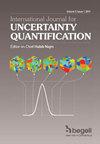GOAL-ORIENTED MODEL ADAPTIVITY IN STOCHASTIC ELASTODYNAMICS: SIMULTANEOUS CONTROL OF DISCRETIZATION, SURROGATE MODEL AND SAMPLING ERRORS
IF 1.8
4区 工程技术
Q2 ENGINEERING, MULTIDISCIPLINARY
International Journal for Uncertainty Quantification
Pub Date : 2020-01-01
DOI:10.1615/int.j.uncertaintyquantification.2020031735
引用次数: 0
Abstract
The presented adaptive modelling approach aims to jointly control the level of renement for each of the building-blocks employed in a typical chain of nite element approximations for stochastically parametrized systems, namely: (i) nite error approximation of the spatial elds (ii) surrogate modelling to interpolate quantities of interest(s) in the parameter domain and (iii) Monte-Carlo sampling of associated probability distribution(s). The control strategy seeks accurate calculation of any statistical measure of the distributions at minimum cost, given an acceptable margin of error as only tunable parameter. At each stage of the greedy-based algorithm for spatial discretisation, the mesh is selectively rened in the subdomains with highest contribution to the error in the desired measure. The strictly incremental complexity of the surrogate model is controlled by enforcing preponderant discretisation error integrated across the parameter domain. Finally, the number of Monte-Carlo samples is chosen such that either (a) the overall precision of the chain of approximations can be ascertained with sucient condence, or (b) the fact that the computational model requires further mesh renement is statistically established. The eciency of the proposed approach is discussed for a frequency-domain vibration structural dynamics problem with forward uncertainty propagation. Results show that locally adapted nite element solutions converge faster than those obtained using uniformly rened grids.随机弹性动力学中目标导向模型的自适应:离散化、代理模型和抽样误差的同时控制
所提出的自适应建模方法旨在共同控制随机参数化系统的典型尼元近似链中使用的每个构建块的更新水平,即:(i)空间域的尼元误差近似(ii)在参数域中插值感兴趣的量的代理建模(iii)相关概率分布的蒙特卡罗采样(s)。控制策略寻求以最小代价精确计算分布的任何统计度量,给定可接受的误差范围作为唯一可调参数。在基于贪婪的空间离散化算法的每个阶段,网格被选择性地重新划分到对期望测量误差贡献最大的子域中。代理模型的严格增量的复杂性是通过强制优势离散误差集成跨参数域控制。最后,选择蒙特卡罗样本的数量,以便(a)近似链的整体精度可以以快速的置信度确定,或者(b)计算模型需要进一步网格修改的事实在统计上确定。讨论了该方法对具有前向不确定性传播的频域振动结构动力学问题的有效性。结果表明,局部自适应有限元解的收敛速度要快于均匀网格解的收敛速度。
本文章由计算机程序翻译,如有差异,请以英文原文为准。
求助全文
约1分钟内获得全文
求助全文
来源期刊

International Journal for Uncertainty Quantification
ENGINEERING, MULTIDISCIPLINARY-MATHEMATICS, INTERDISCIPLINARY APPLICATIONS
CiteScore
3.60
自引率
5.90%
发文量
28
期刊介绍:
The International Journal for Uncertainty Quantification disseminates information of permanent interest in the areas of analysis, modeling, design and control of complex systems in the presence of uncertainty. The journal seeks to emphasize methods that cross stochastic analysis, statistical modeling and scientific computing. Systems of interest are governed by differential equations possibly with multiscale features. Topics of particular interest include representation of uncertainty, propagation of uncertainty across scales, resolving the curse of dimensionality, long-time integration for stochastic PDEs, data-driven approaches for constructing stochastic models, validation, verification and uncertainty quantification for predictive computational science, and visualization of uncertainty in high-dimensional spaces. Bayesian computation and machine learning techniques are also of interest for example in the context of stochastic multiscale systems, for model selection/classification, and decision making. Reports addressing the dynamic coupling of modern experiments and modeling approaches towards predictive science are particularly encouraged. Applications of uncertainty quantification in all areas of physical and biological sciences are appropriate.
 求助内容:
求助内容: 应助结果提醒方式:
应助结果提醒方式:


